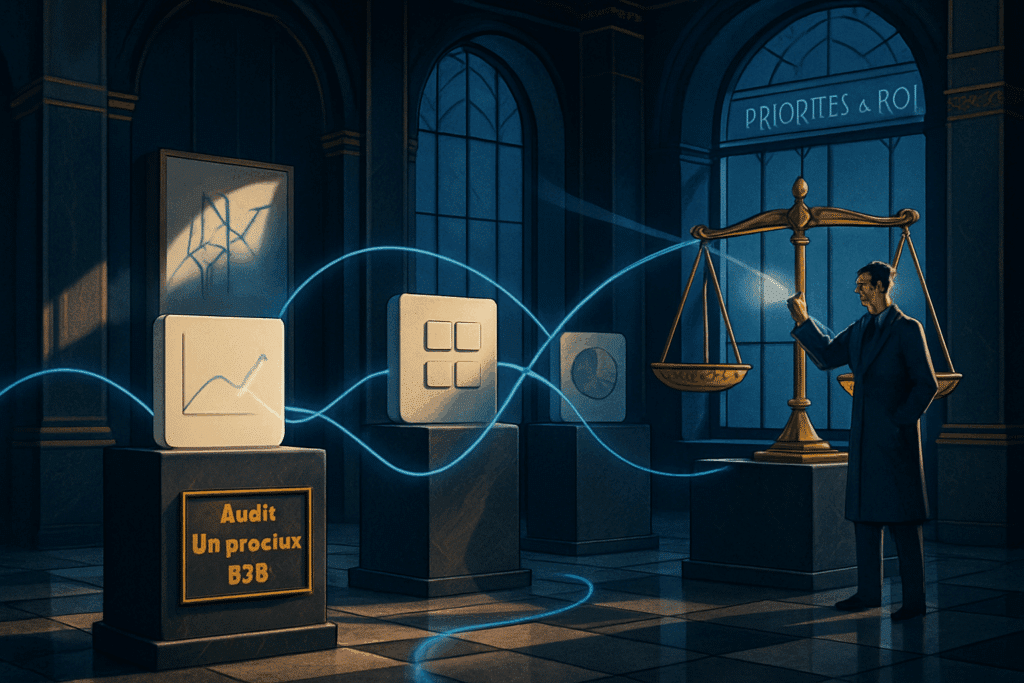Technical SEO optimization for B2B sites: audit & plan
In an increasingly competitive B2B world, organic visibility is no longer a bonus: it’s becoming a strategic lever for attracting qualified prospects. Technical SEO is the foundation that enables expert content – service pages, product sheets, case studies – to be found and valued by search engines. This practical guide explains how to carry out a technical SEO audit tailored to B2B sites and build a prioritized action plan to transform organic visibility into measurable business opportunities.
Marketing departments and managers of industrial companies, professional services or software publishers (SaaS) will find a step-by-step methodology, clear priorities and concrete examples of high value-added actions. The aim: to improve indexing, reduce technical friction and maximize the return on investment of SEO efforts.
This document draws on recognized best practices and industry-standard tools (Google Search Console, Screaming Frog, PageSpeed Insights, SEMrush / Ahrefs) to propose an operational and immediately applicable plan.
Before going into detail, let’s recall the essence of technical SEO:
“Technical SEO concerns all actions aimed at optimizing the structure, performance and navigability of a website to facilitate its exploration and indexing by search engines.”
Sources: WebConversion.fr, SEMJI
Technical SEO optimization for B2B sites: audit & plan
For a B2B site, technical optimization isn’t just about correcting isolated errors: it’s about aligning the technical architecture with the business strategy. A well-executed technical SEO audit provides a clear vision of the obstacles to indexing, identifies priority areas for improvement and enables you to build a coherent, measurable and ROI-oriented SEO action plan.
The objectives of such an audit are multiple: to maximize crawl budget, ensure that pages with high commercial value are highlighted, reduce loading times to improve user experience and Core Web Vitals, and secure site access. Each technical measure contributes directly to organic visibility and, ultimately, to the generation of qualified B2B leads.
Why this subject is essential for companies
Many B2B companies underestimate the impact of technical problems on their organic visibility. Even the best content won’t be enough if search robots can’t crawl it properly, or if pages take too long to load. Here are the main pain points observed:
- Poor URL structures and deep tree structures prevent strategic pages from being indexed.
- Insufficient internal meshing, leading to poor transmission of authority between pages.
- High loading times, penalizing positioning and increasing bounce rates.
- Crawl errors (404, redirect loops) that waste crawl budget and degrade indexing quality.
- Lack of strategy for prioritizing optimization of high-value sales pages (product categories, service pages, offer pages).
- Lack of continuous monitoring: technical regressions often go unnoticed, and cost dearly in lost traffic.
For an SME or ETI, these shortcomings quickly translate into missed opportunities: fewer qualified visitors, fewer sales contacts, and therefore a direct impact on sales. In the B2B context, where the sales cycle is long and the recruitment of qualified leads costly, optimizing the technical base is a cost-controlled lever with an often rapid return on investment.
How Communicators turn challenges into opportunities
When you call on Les Communicateurs, you can turn technical obstacles into levers for growth. The agency combines technical expertise, understanding of B2B issues and ROI-oriented methodology to deliver measurable results:
- Prioritized diagnosis: the audit doesn’t just list errors, it classifies actions according to an impact/effort matrix to guarantee rapid and lasting gains.
- Integrated approach: technical optimization, content and user experience are coordinated to maximize the conversion of organic visitors into sales contacts.
- Automation and monitoring: set up alerts and dashboards to detect regression and steer performance over the long term.
- Skills transfer: training and documentation so that in-house teams can maintain best practices and manage ongoing actions.
- KPI orientation: each action is linked to indicators (qualified organic traffic, indexed pages, loading time, conversions) to measure return on investment.
In concrete terms, Les Communicateurs operates on three complementary lines of action: correcting technical emergencies, optimizing the platform for SEO performance, and establishing governance to ensure lasting results. This approach transforms a technical SEO audit into a genuine strategic optimization plan aligned with business objectives.
Strategies, tools and practical examples
Here’s a practical, step-by-step methodology for carrying out a technical SEO audit and building an effective action plan. Each step includes recommended tools and concrete examples of actions.
1. Structure and internal mesh analysis
Objective: check that the tree structure highlights priority pages and that internal meshing correctly distributes authority.
- Tools: Screaming Frog, Sitebulb, SEMrush, Ahrefs.
- Concrete actions :
- Map the tree structure and identify high-value pages (service pages, product sheets, case studies).
- Reduce the depth of important pages(ideal: < 3 clicks from the home page).
- Set up thematic silos and contextual navigation links (breadcrumbs, internal links in content).
Example: a B2B manufacturer reorganized its product categories and added internal links from case study pages to product sheets: in 4 months, priority product pages saw an average position increase of 6 places.
2. Technical error checking and crawl management
Objective: correct errors that prevent exploration and optimize the crawl budget.
- Tools: Google Search Console, Screaming Frog, Log Analyzer (e.g. Screaming Frog Logs), Ahrefs.
- Concrete actions :
- Identify and correct 404s, redirect loops and server errors (5xx).
- Standardize redirects (301 is preferred) and clean up redirect chains.
- Check robots.txt and sitemap.xml to ensure that strategic pages are crawlable and submitted to search engines.
Example: for a B2B SaaS, the removal of a redirect string used on dozens of pages freed up the crawl budget and enabled Google to explore new product pages more regularly, increasing the indexation rate by 30% in two months.
3. Performance and Core Web Vitals
Objective: reduce loading times and improve Core Web Vitals for user experience and SEO.
- Tools: Google PageSpeed Insights, GTmetrix, WebPageTest, Lighthouse.
- Concrete actions :
- Optimize images (compression, switching to WebP format, lazy loading).
- Minimize and combine CSS/JS files, defer non-critical JS, use preload for critical resources.
- Enable server-side and CDN caching for static resources.
Example: a B2B services company set up a CDN and optimized images: the Largest Contentful Paint was reduced from 3.8s to 1.6s, resulting in a drop in the bounce rate and an increase in the average time spent on key pages.
4. Accessibility and mobile compatibility
Objective: ensure that the site is accessible and performs well on mobile – essential for SEO and user experience.
- Tools: Google Mobile-Friendly Test, Axe, WAVE, audits Lighthouse.
- Concrete actions :
- Validate responsive design and correct display problems (touch targets, text too small).
- Ensure consistent, ergonomic navigation on mobile devices (visible CTAs, optimized forms).
Example: optimizing contact and quote request forms on mobile increased mobile conversions by 22% for a professional services company.
5. Security and HTTPS
The aim is to guarantee security and trust, both of which are essential for user experience and compliance.
- Tools: SSL verification, security tools (Qualys SSL Labs), vulnerability scanner.
- Concrete actions :
- Migrate to HTTPS if necessary and correct mixed content.
- Update CMS and plugins, configure security headers (HSTS, CSP).
6. Tags, microdata and semantic structure
The aim is to make it easier for search engines to interpret content and improve its display in SERPs.
- Concrete actions :
- Check title and meta description tags: unique, descriptive and conversion-oriented.
- Structure content with consistent Hn tags and use alt attributes on images.
- Deploy structured data (schema.org) for products, job offers, customer reviews, FAQs.
Example: the addition of structured data for product pages enabled the appearance of enriched extracts and increased organic CTR by 8% for an industrial client.
7. Monitoring, automation and governance
Objective: prevent regressions, measure impact and automate alerts for technical and marketing teams.
- Tools: Google Search Console, Google Analytics / GA4, Datastudio / Looker Studio, SEMrush Sensor, Screaming Frog Scheduler, Core Web Vitals monitoring tools.
- Concrete actions :
- Set up KPI dashboards (organic traffic, indexed pages, Core Web Vitals, conversion rates).
- Automate regular technical scans and alerts in the event of an increase in 5xx/404 errors or a drop in performance.
- Document processes and train teams (best practice guides, correction playbooks).
Example: an alert plan enabled an SME to identify a regression caused by an e-commerce plugin update. The 24-hour correction prevented a prolonged drop in organic traffic.
Recommended tools cited: Google Search Console, Google PageSpeed Insights, GTmetrix, Screaming Frog, SEMrush, Ahrefs.
Long-term benefits for your company
Investing in a technical SEO audit followed by a prioritized action plan brings tangible and lasting benefits:
- Increased organic visibility: more correctly indexed pages means more opportunities to appear in relevant search results.
- Improved conversion rates: faster pages and clearer paths increase the probability of conversion for B2B visitors (quote requests, sales contacts).
- Lower acquisition costs: by increasing qualified organic traffic, dependence on paid campaigns is reduced, improving marketing ROI.
- Improved operational performance: audit automation, proactive monitoring and documentation reduce the time spent resolving recurring problems.
- Enhanced credibility: a secure, accessible, high-performance site builds trust with prospects and partners.
- Competitive advantage: sustainable positioning on sector-specific queries improves brand awareness and the generation of qualified leads.
In numerical terms, the benefits are measured by indicators: increase in organic traffic (+%), increase in organic conversion rate (+%), reduced loading time (ms), and reduced cost per lead (EUR). The Communicators build dashboards to link each technical SEO action to these KPIs, in order to quantify the return on investment within a short timeframe (generally 3 to 9 months, depending on the scale of the project).
Conclusion: take action with Les Communicateurs
Technical SEO optimization for B2B sites is a structured approach combining technical know-how, content strategy and operational governance. An exhaustive audit followed by a prioritized SEO action plan transforms invisible problems into concrete gains: better indexing, faster pages, optimized user paths and increased qualified leads. The Communicators accompany companies every step of the way – audit, planning, execution and training – to guarantee a lasting impact on organic visibility and sales.
To find out how a technical SEO audit can improve the performance of your B2B site, The Communicators offer an initial diagnosis and a prioritized roadmap tailored to your objectives. Request a consultation to receive a personalized, costed action plan, and start turning your organic visibility into business growth.
Contact Les Communicateurs for a free evaluation of your site and a discussion of priority levers: technical SEO audit, technical optimization, SEO action plan and follow-up strategy – for visible, measurable results.









